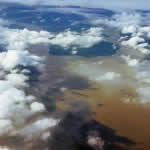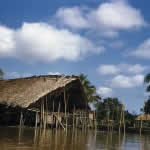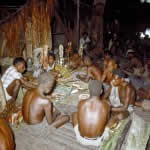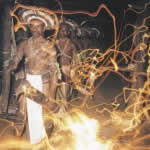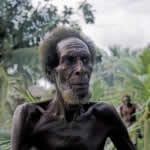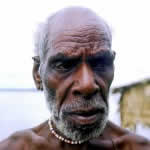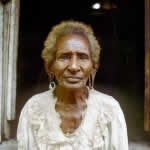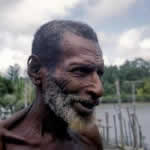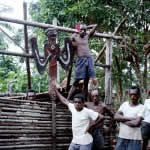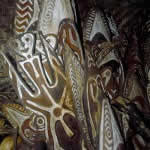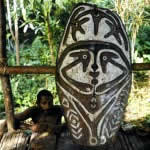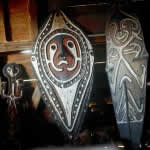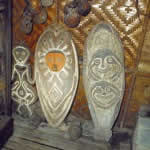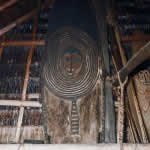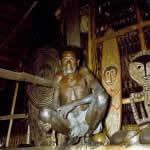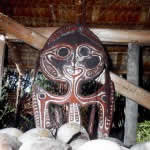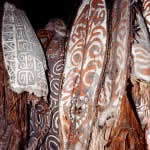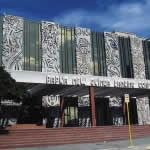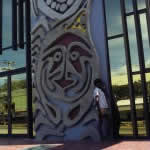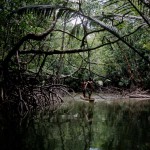a forthcoming e-book publication
Contents:
TITI–
EVOLUTION OF DECORATIVE ART
IN THE PAPUAN GULF REGION
OF NEW GUINEA
I A Personal Foreword (21 pages)
(Text)
Postscriptum on 21st November, 2005
Postscriptum on 15th September, 2006
Postscriptum on 3rd February, 2007
Final Postscriptum
II From the Papuans‘ Point of View – an initial tribute to the Gulf people
(14 pages)
01 A – Tales from the Time of Migration
02 B – Images of Our Dreams: the shaping of ímunu
03 C – A synopsis of the feelings and dreams of the people as documented in
field diaries, in letters and published sources, and how these
expectations ended in agony and despair
III The Physical Environment, with emphasis on the living conditions
and adapations of the native people in their ways of life to the Delta
(8 pages)
IV The Rescue Operation (16 pages)
V Remarks about Research Methods (17 pages)
01 The role of photography in ethnographical research
VI Terms and Definitions (33 pages)
(Text)
Definitions for selected, significant terms:
Evolution
Tribe
Clan and further social units
Totem
Tradition
Tribal culture
Tribal decorative art
Decoration
Design
Style
Further comments on “Style”
Extension of the chapter Terms and Definitions:
VI-02 Alien encounters (8 pages)
VII The Status of Scientific Knowledge (12 pages, incl. A)
(Text)
01 A – Early exploration
02 B – Ethnographical research (17 pages incl. C)
03 C – The first documentations of Papuan Gulf art objects
04 D – Archaeological Research in the Papuan Gulf (7 pages)
VIII A Classification of Decorated Cult and Other Traditional Objects
and their Regional Distribution (14 pages)
IX The Making of Art – Tools and Techniques, the Artists
9 pages)
01 Materials
02 The techniques of making art
03 Making kópe
04 Making hoháo
05 East and west compared
X The Germinal Culture (Lower Fly River) (8 pages)
01 Kiwai visual arts
02gópe and mímia
03 Germinal style elements
XI Early Migrations and Expansion over the Gulf Region (68 pages)
01 The geological evidence
02 The first eastwards migration
03 The Neuri upheaval
04 The first Delta settlement
05 Reflections of the ancestral home
06 Tales about O’uri
07 Further notes about the first migrations
08 Kerewo proper
09 Reviewing the outset
10 Extended eastwards migration
11 Moving from O’a to Urama Island
12 áwae in dúbu wéneh Omau
12 a Urama history unfolding
13 Genealogies Kinomere (collected mostly 1968 and 1970)
14 áwae in dúbu wéneh Daubai (at Kinomere)
15 Diagram of áwae in dúbu wéneh Daubai (at Kinomere)
16 Colonization of the Ivi – Mure Rivers area
17 Spreading over the Wapo – Era Rivers area
18 Raiding Old Baravi and Era-Goiravi villages
19 The discoveries by Th. F. Bevan during is 5th voyage (Nov. – Dec.
20 dúbu mére in the Gope ethnic district
21 The Papuan Gulf – a model of indigenous human expansion
22 Migrations in the Purari Delta and cultural radiation further to the east
23 Final stages of the migration from the Fly River eastwards
24 Further evolutionary aspects
25 Movements of cultural patterns from the Purari Delta westwards
26 Legends of Sido – Hido – Iko.
XII The Head Cult (19 pages)
01 Origins of head-hunting
02 Head-hunters on the war path
03 The beheading knife
04 Preparing the head trophy
05 Bamu River skull trophies
06 The head cult spreads eastwards
07 Regional differentiation in decorating and displaying the head
trophies
08 Introducing the agíbe
09 Kerewo agíbe
10 Turama and Gama Rivers agíbe
11 The agíbe tablets and “cut out figures” – the meaning of the term
“agíbe”
12 The áwae skull shrines in the Urama, Gope and Era – Kipaia ethnic
districts
13 Head cult of the Namau and Elema tribes
14 Significance of the head cult in Papuan Gulf cultures
XIII The gópe and Other Ovoid Ceremonial Objects (27 pages)
(Text)
01 (Oval) board derivates
02 Bullroarers
03 The gópe – kópe – kwói (ko-é) – hoháo
04 The titi ébiha – kaiaímunu
05 The daímo ébiha (Turamarubi ethnic district)
06 The agíbe
07 The ovoid hévehe masks.
XIV Masks and Dance Costumes (19 pages)
(Text)
01 The plaited masks of the west
02 Transition to the bark-cloth covered masks of the east
03 The kanípu and harísu masks
04 The two concepts of mask making in the Papuan Gulf
05 The cone – shaped masks of the eastern Gulf (kováve – eháro)
06 The oval – shaped masks
07 The Hévehe ceremonies of Orokolo
08 The sacred sphere of masks
09 Stylistic annotations (differentiation)
10 Migrations of mask designs and significance of innovative centres
XV obadúbu and iriwáke (20 pages)
01 The mysterious obadúbu.
02Introducing the iriwáke
03 Further unveiling the obadúbu
04 … and the iriwáke
05 Torn and twisted
06 Out of nowhere
07 Further reading – the correspondence with Sotheby’s relating to the
Kiwaumai iriwáke
XVI Spiritual Principles, Ceremonies and Festive Cycles (19 pages)
01 ímunu
02 Origins of the kaiaímunu – ébiha cult
03 Highly sacred – and top secret
04 Ceremonial performances
05 The Obína and other dances
06 The Paírama
07 The Gópi
08 The Erímunu
09 Spreading of ceremonies
10 The Kaikai Oboro
11 The Múguru
12 Festive seasons
13 Vage reflections only…
14 Héwehe – the “Drama of Orokolo”
XVII TITI– the Concept and Evolution of Decorative Design(32 pages)
01 Autonomous tribal society
02 Tribal artistic expression
03 The origins of spiritual power in tribal art
04 The personal – and natural dimensions of sacredness
05 The artist’s potentiality of expression
06 Aesthetics as agents in tribal artistic performances
07 The significance of titi
08 Archaic images – approaching their assessment
09 The oldest effigies under examination
10 Universal prototypes
11 From universal to endemic art presentation
12 Reflections of bygone times
13 Coming to terms with the expression of prototype titi
14 The power of realistic simplicity in artistic expression
15 titi become symbols
16 Towards further objectives in exploring Papuan Gulf art.
14 An excursus into tribal diversity: the example of Kwoma society
15 Comparing west and east (in the Gulf region)
16 Renewal versus innovation
XVIII Modification of Design versus Continuity of Style (71 pages)
01 Theory and factual evidence
02 Geometrical titi
03 Stylistic heritage
04 Comparing geometrical (linear) and figurative titi
05 An interim synopsis
06 Focus on stylistic identity of ethnic units
07 The shaping of style in tribal society
08 Stages in tribal arts evolution
09 Modification or aberration – acceptance or rejection of new
designs
10 Evolutionary differentiation of titi on kópe effigies and other
ceremonial objects in the Urama, Gope and Era – Kipaia ethnic
districts
11 Building a body – with two sets of arms (and legs)
12 Comparison of kópe with hoháo and kwói (mostly) oval board –
shaped effigies
13 The Kerewo titi ébiha and kaiaímunu board – shaped effigies
14 titi on ímunu and kakáme “root figures”, bióma and statues in
round
15 From simple realism towards complexity and abstraction
16 Further aspects of “abstraction”
17 Preferences and interpretations (titi)
18 Concluding remarks
IXX The Present and Future Significance of Papuan Gulf Decorative Art
(34 pages)
(Text)
01 A dramatic shift
02 Mere reflections
03 Sales and sell-out
04 No place at home
05 Trimming the message
06 Fairy-tales unlimited
07 Setting the trend
08“Ancestral” once again
09 The distinct concepts of cultural diversity
10 Who is concerned ?
11 Global perspectives – one stream of evolution
XX Appendices: Maps; collection George Craig; donations to the Papua New Guinea National Museum; bullroarers coll. Michael Hamson and Holger Braun.
Papuan Gulf Bibliography
